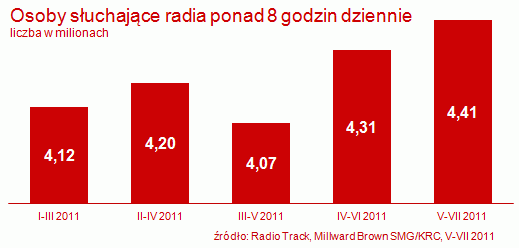
More than half of these listeners, whom Radio Track calls heavy users, have a secondary education, more than double the next group of listeners with higher education.
Breakdown of Radio "Heavy Users" by Education Level
- Secondary - 51.2%
- Higher - 23.3%
- Vocational - 17.8%
- Primary - 7.6%
According to Radio Track, among those spending more than 6 hours with the radio, there is a higher proportion of white-collar workers than in the general population - they make up 22.1% of these listeners. There are also more business owners (10.9%), directors and professionals (14.8%), and skilled laborers (22.4%).
These data are significant due to the advertising potential. It’s no surprise they’re often highlighted, as in a recent release by the Radio Research Committee, which emphasized that company heads listen to their favorite stations more than average.
The listeners who spend the most time with the radio are primarily adults: people aged 25-39 make up 37.8% (significantly more than 29.3% of all respondents), and those aged 40-59 account for 39.3% (compared to 35.7% of all respondents).
It’s worth noting that the increase in people who keep their radios on for long periods may be influenced by the summer season, when Poles traditionally listen to the radio longer and more often. Additionally, programming and music changes are increasingly tailored to meet audience expectations and needs.
COMMERCIAL BREAK
New articles in section Media industry
Advertising market 2025. Poland, Europe and the World
Marcin Grządka
The global advertising market is growing by 8.8% in 2025 and will reach a value of 1.14 trillion dollars. The industry result in Europe records slightly lower dynamics, at the level of 5.8%. In this comparison, Poland performs clearly above the average. We will record an increase of 8.9% this year and a value of 18.56 billion PLN - estimates WPP Media in the annual report "This Year Next Year".
The print media market 2025. Three global trends
Krzysztof Fiedorek
The market value is 359.53 billion dollars, yet the erosion is visible to the naked eye. The decline for newspapers will amount to -2.3 percent. Despite this, print retains strength: it generates 76 percent of subscription revenues and enjoys 82 percent consumer trust. The future of the industry is defined by hybrid strategies and niche specialization.
Journalism in the age of AI. Why people prefer humans over machines
Krzysztof Fiedorek
Only 12% of people accept news created solely by AI, while 62% prefer those written by humans. At the same time, only 19% notice labels indicating the use of artificial intelligence, while younger audiences ask AI to explain the content to them. These are the findings of the Reuters Institute report on artificial intelligence in media.
See articles on a similar topic:
Dead internet theory is a fact. Bots now outnumber people online
Krzysztof Fiedorek
Already 51% of global internet traffic is generated by bots, not people. As many as two-thirds of accounts on X are likely bots, and on review platforms, three out of ten reviews weren't written by a human. Do you feel something is off online? It's not paranoia. In 2025, it's a reality.
Radio Fanatics. Who Listens for One-Third of the Day?
Bartłomiej Dwornik
One in five listeners now spends over 8 hours daily listening to the radio, according to data from the Radio Track study. Since the beginning of the year, the number of these avid listeners has grown by 300,000.
Artificial intelligence in newsrooms. Three realities of the AI era in media
Krzysztof Fiedorek
According to a report by the European Broadcasting Union, many newsrooms already use AI but still do not fully trust it. Audiences do not want "robotic" news, and the technologies themselves though fast can be costly, unreliable, and surprisingly human in their mistakes.
Review of media from around the world. See what they are buzzing about [LINK]
AUTOPROMOCJA Reporterzy.info
What is the media buzzing about? A review of the headlines of the most important newspapers and websites. Events of the day, country, world, media market, economy, sport, foreign media, and even gossip and curiosities. In real time and 24 hours a day. We invite you!





























